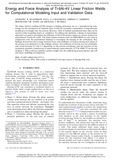JavaScript is disabled for your browser. Some features of this site may not work without it.
| dc.contributor.author | McAndrew, Anthony | |
| dc.contributor.author | Colegrove, Paul A. | |
| dc.contributor.author | Addison, Adrian C. | |
| dc.contributor.author | Flipo, Bertrand C. D. | |
| dc.contributor.author | Russell, Michael J. | |
| dc.date.accessioned | 2016-02-11T09:35:01Z | |
| dc.date.available | 2016-02-11T09:35:01Z | |
| dc.date.issued | 2014-09-26 | |
| dc.identifier.citation | Mcandrew AR, Colegrove PA, Addison AC, et al., (2014) Energy and force analysis of Ti-6Al-4V linear friction welds for computational modeling input and validation data. Metallurgical and Materials Transactions A: physical metallurgy and materials science, Volume 45, Issue 13, December 2014, pp. 6118-6128 | en_UK |
| dc.identifier.issn | 1073-5623 | |
| dc.identifier.uri | https://dx.doi.org/10.1007/s11661-014-2575-8 | |
| dc.identifier.uri | https://dspace.lib.cranfield.ac.uk/handle/1826/9691 | |
| dc.description.abstract | The linear friction welding (LFW) process is finding increasing use as a manufacturing technology for the production of titanium alloy Ti-6Al-4V aerospace components. Computational models give an insight into the process, however, there is limited experimental data that can be used for either modeling inputs or validation. To address this problem, a design of experiments approach was used to investigate the influence of the LFW process inputs on various outputs for experimental Ti-6Al-4V welds. The finite element analysis software DEFORM was also used in conjunction with the experimental findings to investigate the heating of the workpieces. Key findings showed that the average interface force and coefficient of friction during each phase of the process were insensitive to the rubbing velocity; the coefficient of friction was not coulombic and varied between 0.3 and 1.3 depending on the process conditions; and the interface of the workpieces reached a temperature of approximately approximately 1273 K (1000 °C) at the end of phase 1. This work has enabled a greater insight into the underlying process physics and will aid future modeling investigations. | en_UK |
| dc.description.sponsorship | EPSRC, Boeing Company, Welding Institute | en_UK |
| dc.language.iso | en | en_UK |
| dc.publisher | Springer | en_UK |
| dc.rights | Attribution 4.0 International | |
| dc.rights.uri | http://creativecommons.org/licenses/by/4.0/ | |
| dc.subject | Linear friction welding | en_UK |
| dc.subject | LFW process | en_UK |
| dc.subject | Interface force | en_UK |
| dc.subject | Weld interface | en_UK |
| dc.subject | Dynamic friction coefficient | en_UK |
| dc.subject | Welding time | en_UK |
| dc.subject | Convective heat transfer coefficient | en_UK |
| dc.subject | Weld power | en_UK |
| dc.subject | High interface temperature | en_UK |
| dc.subject | Coulombic friction | en_UK |
| dc.subject | Weld energy | en_UK |
| dc.subject | Asperity contact | en_UK |
| dc.subject | Titanium alloy | en_UK |
| dc.subject | Beta-transus temperature | en_UK |
| dc.subject | Conductive heat transfer coefficient | en_UK |
| dc.title | Energy and force analysis of Ti-6Al-4V linear friction welds for computational modeling input and validation data | en_UK |
| dc.type | Article | en_UK |
Files in this item
This item appears in the following Collection(s)
-
Staff publications (SATM) [4410]

